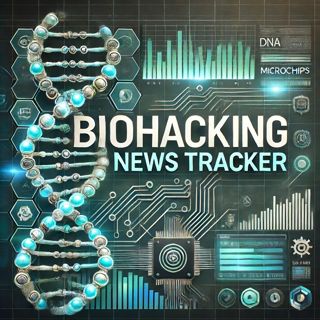
Biohacking Boom: Personalized Health, Wearable Tech, and the Future of Self-Optimization
The biohacking industry is experiencing rapid growth, driven by increasing awareness of health and wellness, advancements in wearable technology, and the rising trend of personalized healthcare. Recent market movements indicate a significant expansion, with the global biohacking market size projected to reach USD 89.65 billion by 2031, growing at a CAGR of 18.6% from 2024 to 2031[1].Key players in the industry are focusing on developing innovative products and services, such as wearable health trackers, genetic testing kits, and smart devices that allow individuals to track and analyze their biometric data. The wearables segment accounted for a significant share of 29.9% in 2023, with current developments focusing on technological progress, such as adding additional health functions and incorporating Artificial Intelligence for personalized suggestions[5].The Asia Pacific region is experiencing rapid growth, driven by increasing investments in biotechnology and healthcare innovations, particularly in countries such as China, India, and Japan. The region is projected to grow by USD 5.99 billion in 2024 and reach over USD 20.89 billion by 2031[1].Recent deals and partnerships include collaborations between pharmaceutical and biotechnology companies, research institutions, and technology firms to develop new biohacking applications. For instance, companies are focusing on biohacking the aging code through nutrigenomics, which studies how nutrition and natural compounds affect human genes to support good health[2].Emerging competitors in the industry include startups and small businesses that are developing innovative biohacking products and services, such as implantable microchips and brain sensors. New product launches include advanced health smartwatches and wearable neurotech devices that allow individuals to monitor and control their biology[2].Regulatory changes are also impacting the industry, with governments implementing policies to support the development of biohacking technologies. For example, the US government is investing heavily in research and development in the biohacking market, driving growth in the region[4].Significant market disruptions include the increasing adoption of biohacking practices by forensic institutes, which is expected to support the growth of the forensic laboratories segment. The segment is projected to record a CAGR of over 21.5% during the forecast period[5].In terms of consumer behavior, there is a growing trend towards self-optimization and personalized healthcare, with individuals seeking methods to enhance their lifespan, prevent or deal with health issues, and optimize their mental and physical abilities. The increasing awareness of health and wellness is driving the growth of the biohacking market, with the hospitals and clinics segment dominating the market in 2023[4].Industry leaders are responding to current challenges by investing in research and development, collaborating with technology firms, and developing innovative products and services. For example, pharmaceutical and biotechnology companies are focusing on developing faster medications, therapies, and personalized health solutions, driving the growth of the pharmaceutical and biotechnology segment[3].Compared to the previous reporting period, the biohacking industry has experienced significant growth, driven by advancements in wearable technology, increasing awareness of health and wellness, and the rising trend of personalized healthcare. The industry is expected to continue growing, with the global biohacking market size projected to reach USD 89.65 billion by 2031[1].This content was created in partnership and with the help of Artificial Intelligence AI
15 Nov 20244min

The Transformative Tide: Biohacking's Meteoric Rise and the Tech Revolution Reshaping Wellness
The biohacking industry is experiencing rapid growth and significant transformations, driven by several key factors.### Market Size and GrowthAs of 2023, the global biohacking market was valued at approximately USD 20-27 billion, depending on the source[2][3][4]. It is projected to grow at a Compound Annual Growth Rate (CAGR) of 15.42% to 19.8% from 2024 to 2030 or 2033, reaching estimated values of USD 78.67 billion to USD 155.63 billion[1][2][4].### Product SegmentsThe wearables segment dominates the market, accounting for a significant share due to the increasing adoption of wearable health trackers, smartwatches, and other health monitoring devices. These devices enable users to track and analyze their biometric data, contributing to a more personalized and data-driven biohacking approach[1][2][3].### Applications and End-UsersThe diagnosis and treatment segment is growing rapidly, driven by the use of biohacking practices such as nootropics and wearable technologies for body enhancement and health monitoring. Pharmaceutical and biotechnology companies are also driving growth, seeking novel solutions to address rising chronic diseases[1][2][4].### Regional InsightsNorth America holds the largest market share, primarily due to heavy investments in research and development and the prevalence of chronic illnesses. The Asia-Pacific region is expected to grow at the fastest rate, driven by increasing healthcare expenditure and a willingness to invest in innovative health solutions[1][2][4].### Consumer BehaviorThere is a significant shift in consumer behavior towards health consciousness and preventive healthcare. Consumers are increasingly adopting wearable devices, smart drugs, and genetic testing kits to monitor and improve their health. This trend is fueled by the desire to enhance lifespan, prevent health issues, and optimize mental and physical abilities[2][3][5].### Regulatory and Technological DevelopmentsRegulatory support for new biohacking applications in drug development is a key driver. Governments and private companies are investing heavily in research and development, leading to the emergence of new technologies such as advanced health smartwatches, neurofeedback devices, and implantable chips[1][3][4].### Market DisruptionsThe biohacking market is experiencing disruptions due to the integration of technologies like Artificial Intelligence (AI) and the Internet of Things (IoT). These technologies enhance the functionality of wearable devices and enable real-time data transmission to healthcare professionals, improving patient outcomes[2][3].### Industry Leaders' ResponsesCompanies like Thync Global, Inc., Health Via Modern Nutrition Inc., Apple Inc., and Fitbit, Inc. are at the forefront of this market. They are focusing on combining technology, science, and human performance to transform well-being. For example, Apple's integration of health monitoring features in its smartwatches and Fitbit's advanced health tracking capabilities are setting industry standards[2].### Supply Chain and Price ChangesThe supply chain is evolving with increased focus on personalized and contextualized products. This has led to more sophisticated manufacturing processes, which in turn may influence pricing. However, detailed price changes are not yet widely reported, but the overall trend suggests that as demand increases, economies of scale could stabilize or reduce prices for biohacking products[3][4].In summary, the biohacking industry is characterized by rapid growth, driven by technological advancements, increasing health consciousness, and significant investments in research and development. As the market continues to expand, it is expected to see further innovations and integrations of AI and IoT, shaping the future of health and wellness.This content was created in partnership and with the help of Artificial Intelligence AI
13 Nov 20244min

"Biohacking Revolutionizes Wellness and Performance Across Industries"
Biohacking has emerged as a revolutionary approach to personal wellness, greatly impacting various sectors, including beauty supplements and athletic performance enhancement. At its core, biohacking involves making incremental and strategic modifications to one’s lifestyle, body, and diet with the aim of enhancing overall well-being and optimizing bodily functions.One notable figure in the biohacking community is Dave Asprey, a prominent biohacker in his fifties whose experiments and lifestyle changes have garnered significant attention. Asprey credits biohacking for substantial improvements in his health and vitality, which has encouraged a wider audience to consider similar practices.Biohacking techniques can vary widely from simple dietary adjustments and sleep modifications to more advanced strategies involving genetic engineering and implant technology. In the realm of beauty, the integration of biohacking has led to the development of advanced health supplements tailored to enhance physical appearance and vitality, by not just focusing on external beauty attributes but also addressing the nutritional needs of the body at a cellular level.Furthermore, high-profile athletes like LeBron James have incorporated biohacking into their training routines, aiming to prolong their athletic performance and recover more effectively from physical exertion. Techniques such as regulated sleep patterns, specific dietary regimens, and advanced physical training protocols are commonly adopted, thus illustrating the versatility and efficacy of biohacking.While the concept of biohacking can be incredibly beneficial, it often requires precise understanding and implementation under professional guidance to avoid potential risks and achieve the desired outcomes safely. As research continues to evolve, biohacking is likely to become more accessible and mainstream, potentially offering new solutions for long-term health and wellness optimization.This content was created in partnership and with the help of Artificial Intelligence AI
12 Nov 20242min

LeBron James Spends $1M Annually on Cutting-Edge Biohacking
Biohacking has emerged as a forefront in professional athlete health management, with NBA superstar LeBron James bringing heightened visibility to the trend, reportedly spending over $1 million annually on biohacking techniques to optimize his physical performance and recovery. This figure, while substantial, reflects the lengths to which elite athletes go to maintain peak physical condition in high-stakes sports industries.Biohacking, essentially, refers to the practice of managing one's own biology using a combination of medical, nutritional, physical, or electronic techniques to enhance the body's natural capabilities. At its core, it involves a deep understanding of science and biology, combined with self-experimentation to improve health, wellbeing, and physical and mental performance.LeBron James's approach includes cutting-edge and sometimes controversial methodologies. Elements such as cryotherapy, hyperbaric oxygen therapy, and strict nutritional regimes highlight his routine. Cryotherapy involves exposing the body to extremely cold temperatures to reduce muscle pain, inflammation, and swelling. On the other hand, hyperbaric oxygen therapy involves breathing pure oxygen in a pressurized room or tube, a technique claimed to speed up the healing of injuries by increasing blood oxygen levels. This meticulous attention to recovery and physical upkeep not only enhances performance but also prolongs his career in a physically demanding league like the NBA.The idea of biohacking was popularized by Dave Asprey, a Silicon Valley entrepreneur who became known for his advocacy of 'The Bulletproof Diet'. Asprey has promoted biohacking through various means, including nutritional strategies, sleep modifications, and more extreme interventions like implanted devices and gene editing.As this practice gains traction, biohacking has evolved into a broader movement with various offshoots. For some, it focuses on dietary adjustments to improve health; for others, it may include integrative technologies such as wearables that monitor physiological data to optimize personal health.Despite its growing popularity, biohacking comes with controversies and criticisms, largely centered around the ethics and safety of self-experimentation and the potential for exacerbating socioeconomic disparities in health. Moreover, the scientific community often scrutinizes the efficacy of certain biohacking techniques, urging caution over quick fixes and the allure of extreme personal optimization.LeBron James's endorsement and substantial financial commitment underscore a modern reality where the boundaries of sports performance are continually pushed. Athletes and individuals alike are increasingly turning to biohacking as a means to surpass conventional health and physical boundaries, signaling a shift towards more personalized and proactive approaches to health and fitness. The permanence of such trends will depend on future scientific validations and ethical considerations in the evolving biohacking landscape.This content was created in partnership and with the help of Artificial Intelligence AI
10 Nov 20243min

"Biohacking Emerges as High-Profile Trend, With LeBron James Leading the Charge"
Biohacking has emerged as a groundbreaking trend in the realm of personal health optimization, attracting both public figures and private individuals aiming to push the boundaries of human performance and longevity. Among the most notable adherents of biohacking is NBA superstar LeBron James, who purportedly invests around $1.5 million each year into his physical well-being. This considerable sum is spent on a variety of treatments and technologies designed to maximize his athletic performance and recovery, demonstrating a high-profile example of how far some are willing to go to maintain and enhance their physical capabilities.Biohacking, in essence, involves applying principles of biology in a DIY approach to enhance the body’s function. The practice can range from simple dietary changes and fitness routines to more advanced interventions like gene editing and the use of wearable technology to monitor bodily functions. Advocates of biohacking like James use a combination of these techniques to tailor personal health and fitness regimes that aim for not just maintenance, but optimal functioning of the body.Similarly, individuals like Kenneth Scott pursue biohacking from a different angle – that of reversing aging. At 81, Scott exemplifies a more radical pursuit within the biohacking community, investing substantial amounts of money and traveling internationally to avail himself of experimental treatments. His regimen eschews conventional practices—in his case, even common hygiene products like soap—to prioritize interventions that he believes will extend his lifespan and improve quality of life.Biohacking has stirred interest and controversy alike. Proponents argue that biohacking empowers individuals by providing personalized solutions that enable a greater control over their biology. Critics, however, raise ethical concerns and highlight the potential health risks associated with untested or scientifically dubious treatments.Despite these debates, the adoption of biohacking practices continues to grow, influenced by successes reported by high-profile figures such as LeBron James. As the technology and understanding of human biology evolve, biohacking stands to play a significant role in shaping future approaches to health care, sports performance, and aging. With increasing attention on and investment in these practices, the potential for transformational changes to health and longevity appears both promising and profound.This content was created in partnership and with the help of Artificial Intelligence AI
9 Nov 20242min

Romania Inaugurates First Longevity Hub as Biohacking Gains Global Traction
Biohacking is gaining traction globally as a means to enhance human capabilities and improve health outcomes, evident from recent developments such as the inauguration of Romania's first longevity hub, Expand Labs, in Bucharest. This facility represents a significant step in Romania's engagement with the biohacking community and focuses on preventive health, longevity, and the optimization of human biology through various biohacking methods.Biohacking itself encompasses a wide range of activities including the usage of wearable technology to monitor body metrics, self-experimentation through genetic engineering, and the modification of personal biology with nutrient management, all aimed at enhancing physical or cognitive performance. Biohackers often use data-driven approaches and digital tools to understand their bodies better and make precise interventions to optimize health and function.The growth of the biohacking market is poised to accelerate, with projections seeing substantial expansion between 2024 and 2032. This growth is partly driven by the increasing availability of technologies that facilitate detailed self-monitoring and personal data collection. Popular trends within the biohacking community include brain enhancements, performance improvement, and longevity extension. Emerging products specifically designed for biohackers, such as implantable sensors and specialized nutrient regimes, underline the specialized nature of this field.Additionally, the rise of biohacking is paralleled by the mainstreaming of its practices, as indicated by the discussion in platforms like the "Bangkok Post," which recently described biohacking as utilizing principles from diverse sciences such as biology, genetics, neuroscience, and nutrition. The term, while still relatively novel to the public lexicon, is quickly becoming recognized as a legitimate form of self-improvement backed by science and technology.As biohacking continues to evolve, its impact is not limited to individual enthusiasts but extends to healthcare, wellness industries, and even policy-making, whereby regulatory frameworks are beginning to catch up with these advancements to ensure safety and efficacy in the practices being adopted by biohackers worldwide. Thus, Romania's entry into this field with a dedicated longevity hub represents not only a national milestone but also a part of a larger global movement toward advanced personal health management.This content was created in partnership and with the help of Artificial Intelligence AI
7 Nov 20242min

Biohacking Fuels Elite Athlete Performance: LeBron James Invests $1.5M Annually
Biohacking has emerged as a progressive methodology embraced notably by athletes such as LeBron James and enthusiasts seeking to enhance their physical and cognitive performance through sophisticated medical, nutritional, and technological strategies. LeBron James, a prominent NBA superstar, reportedly allocates approximately $1.5 million annually to his biohacking regimen, indicating the high value and priority he places on maintaining and enhancing his physical condition and athletic performance.Biohacking encompasses a wide range of practices. Among them, oxygen therapy, red light therapy, and the use of infrared saunas stand out both for their purported benefits and popularity. Oxygen therapy enhances oxygen intake, potentially boosting energy levels and improving recovery rates post-physical exertion. Meanwhile, red light therapy is famed for its potential to reduce inflammation and promote cellular restoration. Infrared saunas are equally prized, their heat purportedly aiding in detoxification and providing deep muscular relief, which is essential for athletes involved in high-intensity sports.This personalized approach to health and fitness, grounded in optimizing biological functions, exemplifies modern efforts to extend the prime years of athletes’ careers. The concept of biohacking aligns with increasing desires for longevity and enhanced quality of life, enabling individuals like James to push the boundaries of conventional athletic performance norms. By integrating cutting-edge technologies and therapies into their regular routine, athletes can achieve and maintain peak performance levels, possibly exceeding established career expectations in demanding physical sports such as basketball.This investment in health optimization through biohacking highlights a broader trend where elite performance and wellness strategies converge, suggesting a future where such practices could become mainstream in professional sports and beyond. The implications of biohacking are vast, potentially ushering in a new era of athletic prowess characterized by heightened longevity and reduced incidence of injury, reshaping professional sports in profound ways.This content was created in partnership and with the help of Artificial Intelligence AI
5 Nov 20242min

Biohacking, Private Train Cars, Lavish Estates, and Wellness Festivals: Exploring the Diverse Landscape of Luxury Lifestyles
Biohacking has steadily garnered public attention as individuals strive to optimize their bodies and potentially extend their life span, seeking what some might consider audacious goals like "cheating death." This pursuit often involves a combination of medical, nutritional, and electronic techniques aimed to enhance the human body's capabilities and repair processes. Biohackers, from professionals with backgrounds in science and medicine to amateurs passionate about biology, typically experiment with a range of techniques—from gene editing and nootropics to implantable devices aimed at improving physical and cognitive performance.In a seemingly disparate but equally exclusive vein, another niche lifestyle is that of private train car ownership. Organizations like the American Association of Private Railroad Car Owners represent individuals who own and maintain these rolling pieces of heritage. These luxury cars offer a throwback to a grander, more leisurely age of travel, customized and outfitted to suit the lavish tastes of their owners. This form of travel provides a unique perspective on luxury, combining the romance of old-world travel with the modern amenities of today.Real estate also plays a significant part in the luxury lifestyle segment, exemplified by properties like former President Donald Trump's marquee estate. High-profile homes like Trump's mansion not only represent significant investment opportunities but also serve as symbols of status and personal achievement. These estates often come with vast histories, bespoke designs, and opulent furnishings, catering to a very exclusive market that values both luxury and exclusivity.On the cultural side, events like the Alma Festival at Six Senses Ibiza offer a soulful blend of luxury and wellness. Scheduled for November 6 to 9, this festival harnesses the brand's ethos of integrating wellness and rejuvenation with luxury experiences. The event proposes an engaging lineup aimed at enhancing both physical and spiritual well-being, designed to attract not only international visitors but also the local public.This mixture of lifestyle news demonstrates the varied interests and pursuits of those who engage in luxury and avant-garde living—from personal enhancements through biohacking to the ownership of private train cars, opulent real estate, and holistic festival experiences. Each element contributes to a broader narrative of individuals seeking exceptionalism either in personal capabilities, travel, living standards, or cultural enrichment.This content was created in partnership and with the help of Artificial Intelligence AI
3 Nov 20242min





















